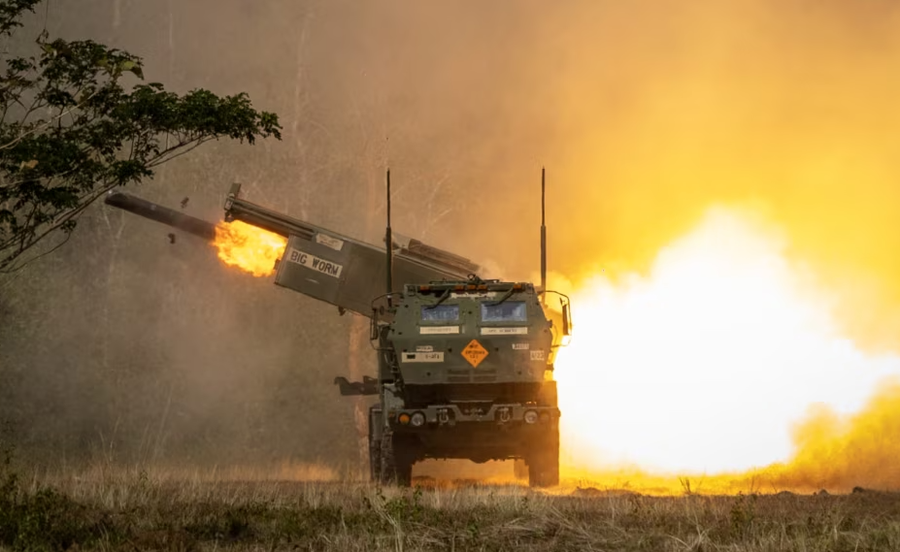
Global military spending reached $2,718 billion in 2024, representing a 9.4 percent increase in real terms compared to 2023 and the largest annual increase since at least the end of the Cold War.
This is according to a new report published on April 28 by the Stockholm International Peace Research Institute (SIPRI). According to the report, military spending has increased in all regions of the world, with particularly rapid growth recorded in Europe and the Middle East.
The top five military spenders – the United States, China, Russia, Germany and India – account for 60 percent of global spending, and together these countries have spent $1,635 billion.
Military spending refers to all government expenditures on military forces and activities, including salaries and benefits, operational expenses, weapons and equipment purchases, military infrastructure construction, research and development, administration, command and support.
The biggest increase in global military spending since the end of the Cold War
SIPRI said this is the tenth consecutive year of global military spending growth. The 15 countries with the highest military spending in the world all increased their military spending in 2024, according to the report. The global military burden – the share of global gross domestic product devoted to military spending – rose to 2.5 percent in 2024.
“Over 100 countries around the world increased their military spending in 2024. As governments increasingly prioritize military security, often at the expense of other budget sectors, the economic and social trade-offs could have significant consequences for societies in the years to come,” said Xiao Liang, researcher in the Military Expenditure and Arms Production Programme at SIPRI.
Increasing military spending in Europe
According to SIPRI, military spending in Europe, including Russia, increased by 17 percent to $693 billion, and European states were the main contributors to the global increase in military spending in 2024.
With the war in Ukraine now in its third year, military spending continued to rise across the continent, pushing European spending levels past the record highs set at the end of the Cold War.
According to SIPRI, all European states increased their military spending, except Malta.
Russia's military spending reached about $149 billion in 2024, an increase of 38 percent compared to 2023. This figure also represents a doubling of the level of military spending compared to 2015. This figure constitutes 7.1 percent of Russia's Gross Domestic Product and 19 percent of all Russian Government spending.
Meanwhile, Ukraine's total military spending, which is facing a war with Russia in 2022, rose by 2.9 percent to $64.7 billion — equivalent to 43 percent of Russia's spending. At 34 percent of GDP, Ukraine had the highest military burden of any country in 2024.
"Russia once again significantly increased its military spending, further deepening the gap with Ukraine," said Diego Lopes da Silva, senior researcher in the Military Expenditure and Arms Production Programme at SIPRI.
"Ukraine currently dedicates all of its tax revenues to the military. In such a tight fiscal space it will be difficult for Ukraine to continue to increase its military spending," he added.
According to the report, several countries in Central and Western Europe have seen unprecedented increases in military spending during 2024, as they have implemented large spending commitments and large arms acquisition plans.
Germany's military spending, according to SIPRI, increased by 28 percent and reached $88.5 billion, making Berlin the largest military spender in Central and Western Europe and the fourth largest in votes.
"For the first time since reunification, Germany has become the largest military spender in Western Europe, which is the result of the special €100 billion defense fund approved in 2022," said Lorenzo Scarazzato, researcher in SIPRI's Military Expenditure and Arms Production Programme.
"Recent policies, adopted in Germany and many other European countries, suggest that Europe has entered a period of high and rising defense spending, which is likely to continue in the near future," he added.
Another European country, Poland, increased military spending by 31 percent or $38 billion.
The United Kingdom also recorded an increase in military spending by 2.8 percent, reaching $81.8 billion, ranking sixth in terms of the largest military spending in the world.
Meanwhile, France's military spending increased by 6.1 percent, reaching $64.7 billion and making it the ninth-largest spender.
NATO countries' spending
All NATO member countries, according to SIPRI, increased their military spending in 2024. Total military spending by NATO member countries reached $1,506 billion, which accounts for 55 percent of global military spending.
Of the 32 NATO member countries, 18 spent at least 2 percent of their Gross Domestic Product on their military, up from 11 countries in 2023, marking the highest number since the adoption of this spending guideline in 2014.
US military spending increased by 5.7 percent, reaching $997 billion, representing 66 percent of NATO spending and 37 percent of global military spending in 2024. A large part of the US budget for 2024 was dedicated to modernizing military capabilities and the nuclear arsenal, with the aim of maintaining a strategic advantage over Russia and China.
Meanwhile, European NATO countries spent a total of $454 billion, accounting for 30 percent of the Western military alliance's overall spending.
Sweden increased its military spending by 34 percent in 2024, reaching $12 billion. In its first year as a NATO member, Sweden's military burden amounted to 2.0 percent of Gross Domestic Product.
"Rapid increases in spending among European NATO countries were driven mainly by the ongoing threat from Russia and concerns about a possible US withdrawal from the alliance," said Jade Guiberteau Ricard, researcher in the SIPRI Military Expenditure and Arms Production Programme.
"It is worth noting that increased spending does not necessarily translate into a significant increase in military capabilities or independence from the US. These are much more complex tasks," Ricard added.
Increase in military spending in the Middle East
Military spending in the Middle East reached an estimated $243 billion in 2024, representing a 15 percent increase compared to 2023 and 19 percent more than in 2015.
Israel’s military spending rose by 65 percent to $46.5 billion — the biggest annual increase since the Six-Day War in 1967 — as the country continued fighting in Gaza and escalated its conflict with Hezbollah in southern Lebanon. Israel’s military burden (military spending as a percentage of gross domestic product) rose to 8.8 percent, the second highest in the world, the SIPRI report said.
In Lebanon, military spending increased by 58 percent in 2024, reaching $635 million. This increase came after Lebanon had had low levels of military spending for several years due to the economic crisis and political instability.
“Despite expectations that many Middle Eastern countries would increase military spending in 2024, large increases were limited to Israel and Lebanon,” said Zubaida Karim, a researcher in the SIPRI Military Expenditure and Arms Production Programme. “In other countries, there were either no significant increases in response to the war in Gaza, or they were hampered by economic difficulties.”
Last year, Saudi Arabia was the largest military spender in the Middle East and the seventh largest in the world. Its military spending rose modestly by 1.5 percent to $80.3 billion, but it was still 20 percent lower than in 2015, when the Middle Eastern state's oil revenues reached record levels.
Meanwhile, in Iran, military spending fell by 10 percent in real terms, or to $7.9 billion in 2024. This decline occurred despite Tehran, according to SIPRI, becoming involved in regional conflicts and supporting armed allies in the region.
SIPRI said international sanctions have significantly limited Iran's ability to increase defense spending.
China continues to increase military spending
China, the world's second-largest military spender, increased its spending by 7 percent in 2024, reaching about $314 billion. Beijing marks three decades of consecutive increases.
China - the world's second-largest economy after the US - accounts for 50 percent of military spending in Asia and Oceania, as Beijing has invested in modernizing its military, expanding its cyberwarfare capabilities and nuclear arsenal.
In neighboring countries, Japan increased spending by 21 percent, or $55.3 billion. This is the largest annual increase in Japan since 1952.
India, the world's fifth-largest military spender, spent $86.1 billion in 2024 - an increase of 1.6 percent, according to the SIPRI report.
In Taiwan, the self-governing island that China claims as its own, spending rose 1.8 percent, reaching $16.5 billion.
"Major military spenders in the Asia-Pacific region are increasingly investing in advanced military capabilities," said Nan Tian, director of SIPRI's Military Expenditure and Arms Production Programme.
"With several unresolved disputes and rising tensions, these investments risk plunging the region into a dangerous arms race spiral," Tian added.
SIPRI said this is the second consecutive year that military spending has increased in five geographical regions of the world, highlighting geopolitical tensions around the world./ REL (A2 Televizion)











